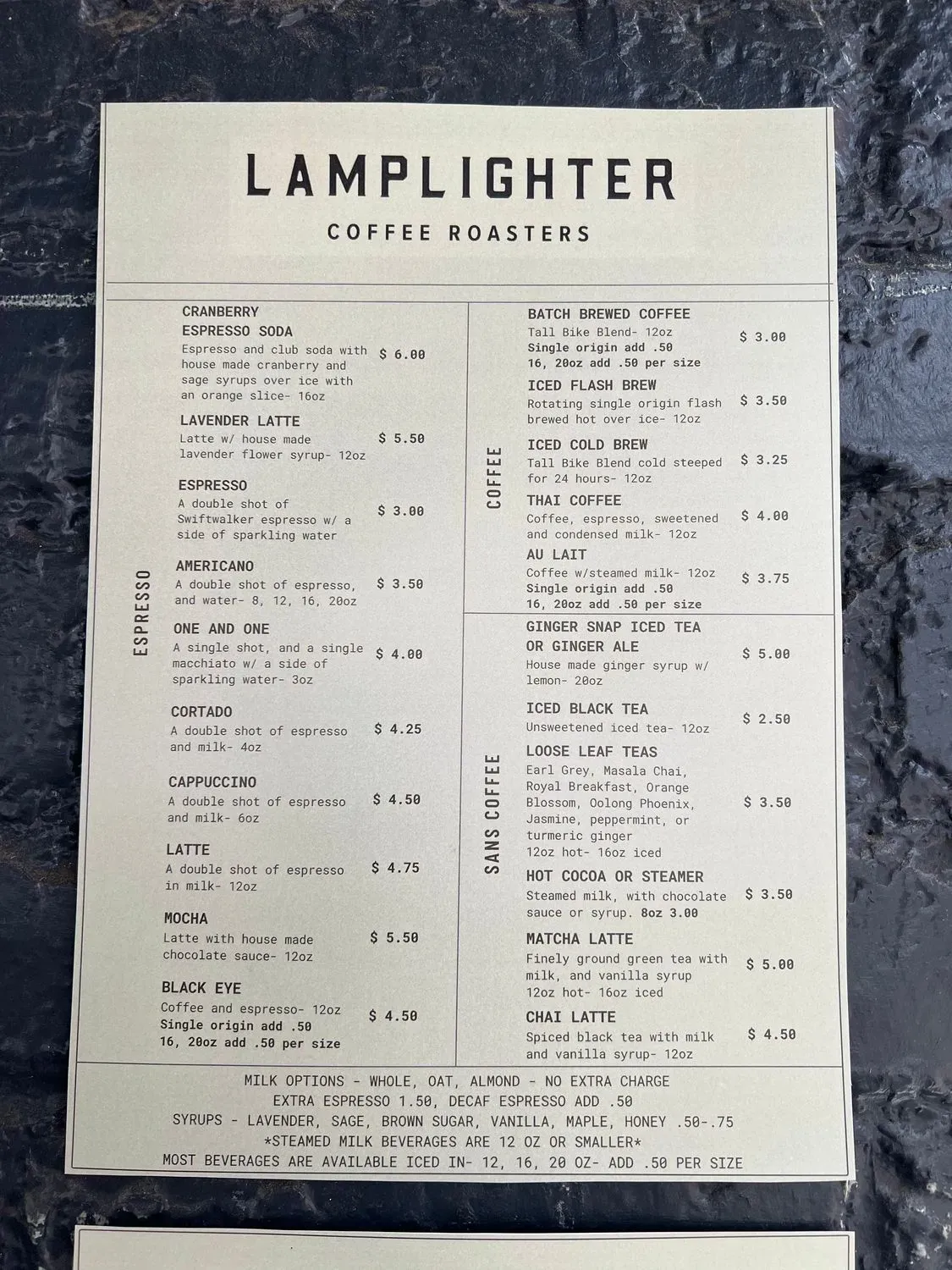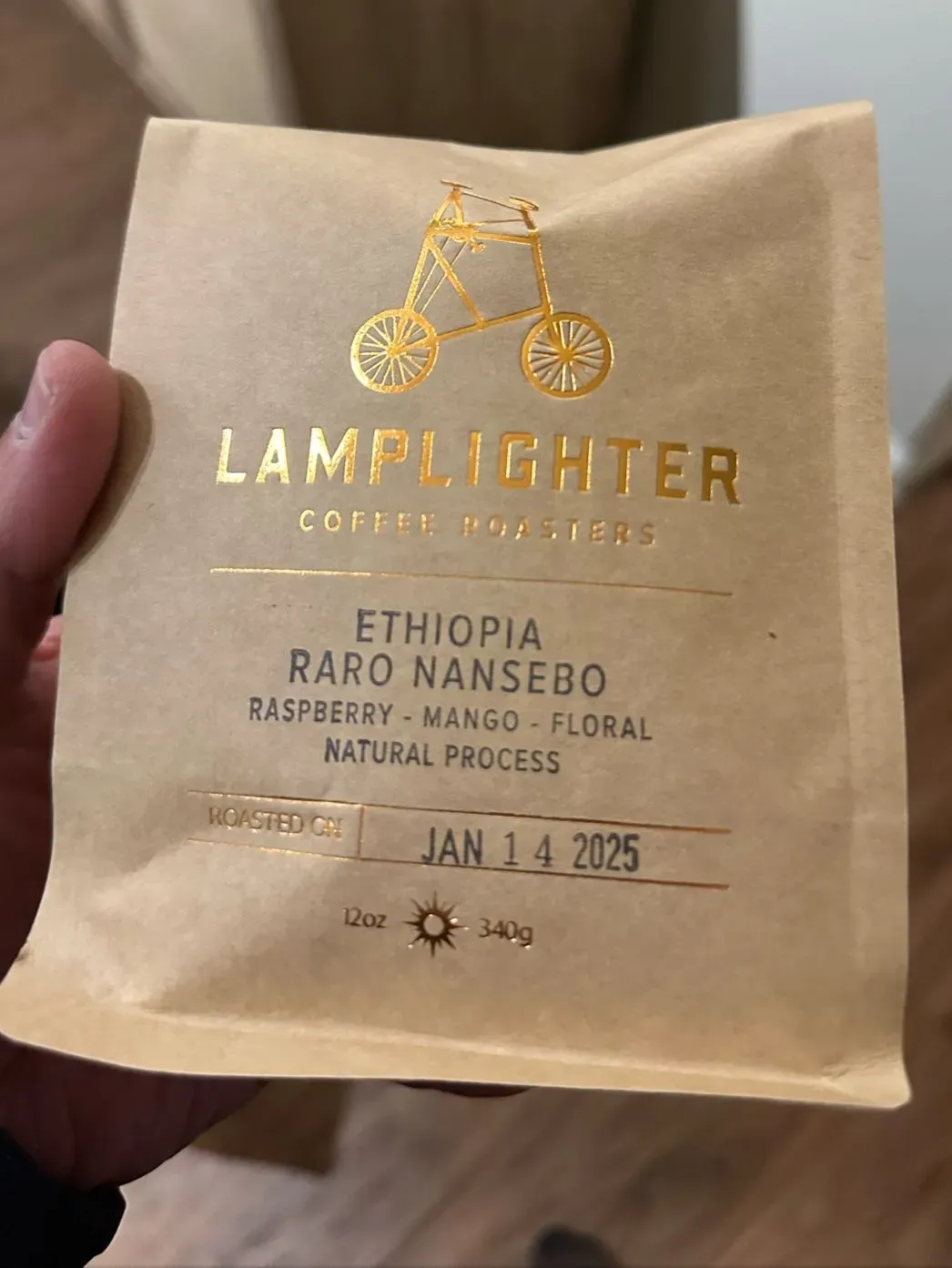Search
Lamplighter Coffee Roasters - Addison St Menu
4.6
(1,050+ Reviews)
SPECIALS
- LAVENDER LATTEA double shot of Swiftwalker espresso, and 10oz of steamed milk with our house made lavender flower syrup. Can also be served iced!
- CRANBERRY ESPRESSO SODAEspresso and soda water with cranberry and sage syrups, served over ice with an orange slice.
- ICED FLASH BREW-BRAZIL(NATURAL PROCESS) Flash chilled iced coffee retains more of the brighter and more delicate flavor notes. We offer a rotating selection of single origin
- GINGER ALE20 oz house made ginger ale with lemon slices$5.00
- GINGER SNAP ICED TEA20 oz iced black tea with house made ginger syrup and lemon slices$5.00
PASTRIES
- PUMPKIN BREADa slice of house made vegan pumpkin bread$4.00
- CHOCOLATE MATCHA CUPS3pack Three dark chocolate candies made with Matcha green tea and cashew butter (vegan)$2.50
- BLUEBERRY MUFFINSALTED OATMEAL DATE COOKIE$4.25
- SALTED OATMEAL DATE COOKIE$4.00
COFFEE AND ESPRESSO
- BATCH BREWClassic drip coffee- Choose Tall Bike Blend or one of our rotating single origin coffees.
- BLACK EYEhot batch brewed coffee or cold brew with a double shot of espresso added
- AU LAITbatch brewed coffee with 1/4 steamed milk
- COLD BREW24 hour cold steeped iced coffee
- LATTE10 oz of steamed milk with a double shot of Swiftwalker espresso-can also be served iced in other sizes
- MOCHA10 oz of steamed milk and house made chocolate sauce with a double shot of Swiftwalker espresso- can also be served iced in other sizes
- THAI COFFEEbatch brewed coffee, espresso, and sweetened condensed milk- can be served hot or iced
- ESPRESSOa double shot of Swiftwalker espresso served with a side of sparkling water$3.00
- AMERICANO10 oz of hot water with a double shot of Swiftwalker espresso- can also be served iced in other sizes$3.50
- CORTADO3 oz of steamed milk and a double shot of Swiftwalker espresso$4.25
- CAPPUCCINO5 oz of steamed milk with a double shot of Swiftalker espresso$4.50
- TURBO COKEreal cane sugar coca-cola with a double shot of Swiftwalker espresso added-served over ice$4.00
SPECIALTY DRINKS
- CHAI TEA LATTEhouse made spiced black tea concentrate with steamed milk and vanilla syrup- can also be served iced in other sizes, or with espresso added
- ICED BLACK TEAclassic unsweetened iced tea from Rishi- can be served sweet with simple syrup upon request
- HOT COCOA10 oz of steamed milk with house made chocolate sauce or other specialty syrup
- LOOSE LEAF TEASa rotating selection from Rishi and Royal Teas- can be served as a Tea Latte with steamed milk, or steeped and flash chilled over ice
- MATCHA LATTEfinely ground green tea with steamed milk and house made vanilla syrup- can also be served over ice$5.00
BOTTLES AND JARS
- COLD BREW CONCENTRATE24 hour cold brewed iced coffee concentrate in a mason jar- store cold in concentrate form, mix 50/50 with water or milk and pour over ice when ready to enjoy- stays fresh for up to 2 weeks.$9.50
- CHAI TEA CONCENTRATELightly sweetened house made chai tea concentrate a mason jar- shake before serving, mix 50/50 with milk, and pour over ice or heat on stovetop- stays fresh for up to a week$7.50
- COKE BOTTLE12 oz classic glass bottle coca-cola with real cane sugar- hecho en Mexico$3.00
- SPARKLING WATER$3.00
- BOTTLED SPRING WATER$1.75
- NAKED JUICE15.2 fl oz$4.50
- JUICE BOXES$1.50
- ORANGE JUICE- 10oz$2.50
BREAKFAST
- BREAKFAST BURRITOScrambled eggs, seasoned potatoes, black beans, and avocado, served with a side of house made salsa. Served with or without an added protein, select your choice below.
- VEGAN BREAKFAST BURRITOTofu scramble, seasoned potatoes, black beans, avocado, and tofutti sour cream, served with a side of house made salsa. Served with or without vegan sausage, select your choice below.
- EGG AND CHEESEFried egg and cheddar on a Cupertino's bagel. Add a protein, or veggies, or substitute Havarti cheese or scrambled eggs if you like!
- LOX BAGELSmoked salmon, and cream cheese with tomato, onion, and capers on your choice of bagel.$13.00
- YOGURT AND GRANOLA PARFAIT W FRESH FRUITIndian Dahi yogurt, and fresh fruit with our house made granola$6.00
- BAGELSToasted locally made Cupertino's bagels with choice of cream cheese or V Tofutti spread$3.75
- THE SLAMMERToasted bagel with Tofutti V cream cheese with a maple Sriracha glazed vegan sausage patty$6.00
- THE SLAYERtoasted bagel and cream cheese with a maple Sriracha glazed pork sausage patty$6.00
COFFEE BEANS
- RWANDA GITESI$18.00
- ETHIOPIA KAYON MOUNTAIN - NATURAL PROCESS$19.00
- DECAF COLOMBIA HUILA- SUGAR CANE PROCESSTasting Notes: tart cherry, red plum, vanilla+++There are a few ‘natural’ ways to decaffeinate coffee - meaning no synthetic chemicals or chemically derived solvents are used. The Sugar Cane (also called Ethyl Acetate or EA Process) begins with fermenting molasses derived from sugarcane to create ethanol, and mixing with acetic acid (naturally created in vinegar) to create ethyl acetate. The coffee is put in a steam bath which opens up the cellular structure of the coffee and allows the E.A. to wash over the beans to dissolve the caffeine. The caffeine is then filtered out, beans are steamed again to remove residual E.A., then dried and shipped. In many coffee producing countries (especially Colombia!) sugarcane is grown in abundance, so it makes sense to use this naturally occurring solvent to decaffeinate coffee at origin. This method also drastically reduces the amount of fuel used to get the coffee to its final destination, since it cuts out the shipment to a far flung decaffeination plant. The coffee is decaffeinated in Colombia, often very nearby the mill where it is processed, which has the added bonus of leaving more of the profits from production in coffee producing countries. Of all the decafs we tasted, the sugarcane options all had the sweetest, most balanced and pleasing cup!$16.00
- SWIFTWALKER ESPRESSO BLENDTasting notes: red apple, milk chocolate, caramel 2/3 Colombia, an 1/3 Ethiopia.
- TALL BIKE BLENDTasting notes: cocoa, almond, fig, and cherry. Colombian, Costa Rican, and Guatemalan coffees
MERCHANDISE
- KALITA WAVE DRIPPER$38.00
- KALITA WAVE FILTERS-185$14.00
- METAL STRAW$1.50
BREWING GEAR AND WARES
- KALITA WAVE DRIPPER$38.00
- KALITA WAVE FILTERS-185$14.00
- METAL STRAW$1.50
- HUMPTY DUMPTY TRAIN HOPPER TEEEspresso brown ink on sand colored 100% cotton tee. All gender sized S-XXL. Designed and drawn by James Travis and silkscreened by Jered Fykes.$20.00
BAKERY AND BREAKFAST
- BREAKFAST BURRITOScrambled eggs, seasoned potatoes, black beans, and avocado, served with a side of house made salsa. Served with or without an added protein, select your choice below.
- VEGAN BREAKFAST BURRITOTofu scramble, seasoned potatoes, black beans, avocado, and tofutti sour cream, served with a side of house made salsa. Served with or without vegan sausage, select your choice below.
- EGG AND CHEESEFried egg and cheddar on a Cupertino's bagel. Add a protein, or veggies, or substitute Havarti cheese or scrambled eggs if you like!
- LOX BAGELSmoked salmon, and cream cheese with tomato, onion, and capers on your choice of bagel.$13.00
- YOGURT AND GRANOLA PARFAIT W FRESH FRUITIndian Dahi yogurt, and fresh fruit with our house made granola$6.00
- BAGELSToasted locally made Cupertino's bagels with choice of cream cheese or V Tofutti spread$3.75
- THE SLAMMERToasted bagel with Tofutti V cream cheese with a maple Sriracha glazed vegan sausage patty$6.00
- THE SLAYERtoasted bagel and cream cheese with a maple Sriracha glazed pork sausage patty$6.00















